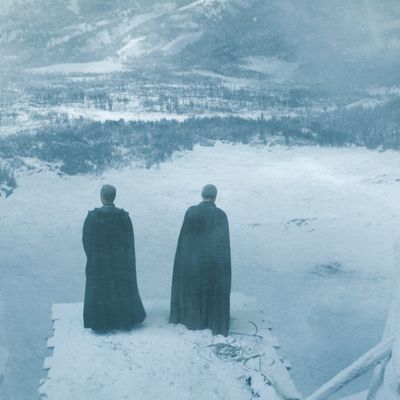
Spoilers below for the Game of Thrones season-seven finale.
For years, Game of Thrones fans have speculated about how the Night King and the White Walkers would eventually make their way south of the Wall. One theory surmised that the seas around Westeros would freeze and they would simply walk around it. Another suggested that the mark the Night King gave Bran in season six would allow the Walkers to bypass the Wall’s magic and pass through unharmed. Clearly, nobody read the tea leaves carefully enough: We didn’t really think the Night King would just bring that bad boy down like the walls of Jericho.
But that’s precisely what happened in the Game of Thrones season-seven finale, “The Dragon and the Wolf.” After the White Walkers march to the Eastwatch portion of the Wall, the Night King rides in on Viserion, who now breathes some kind of blue dragonfire. (Tormund and Beric Dondarrion witness the carnage firsthand, though it’s hard to tell if they survive.) The undead dragon topples a section of the Wall within minutes, and the season ends just as White Walkers begin their invasion of Westeros.
So, how exactly did the Wall come crashing down? To answer that question, we’ll need to understand how it was built in the first place. George R.R. Martin has explained that “more than ice went into the raising of the Wall,” reminding readers of the Song of Ice and Fire series that “these are fantasy novels.” Although Martin has shrouded the specifics of the Wall in a layer of frost, we do know quite a few about its history. It was allegedly constructed by Brandon the Builder (it’s no coincidence that Bran Stark shares his name), the founder of House Stark, with the help of giants and the Children of the Forest. According to the Westerosi myth, they built the Wall roughly 8,000 years ago at the end of the first Long Night. Its entire purpose is to keep the White Walkers out of Westeros, though as centuries passed, it also became a dividing line between the Seven Kingdoms and the Freefolk.
The Wall, Martin has explained, “was much smaller when first raised. It took hundreds of years to complete and thousands to reach its present height.” (At the time of its collapse, it’s about 300 miles long and 700 feet high in some places.) A mixture of ice and rock, it weeps on the outside, but its core never melts and climbers can expect sudden sheets of ice to crack and slide off in an instant, as we saw in season three when Jon climbed the Wall alongside several wildlings who tumbled to their deaths.
But as Martin said, the Wall doesn’t keep out invaders by sheer enormity alone. In A Storm of Swords, when Bran and the Reeds encounter Sam and Gilly in the Nightfort, Sam offers an explanation for how he discovered the gate that leads beneath the Wall. He and Gilly encountered a man they call Coldhands, a rider dressed in all black with a covered face, who explained that “only a man of the Night’s Watch can open” the gate. Coldhands didn’t pass through the gates with them, though. Why not? “The Wall is more than just ice and stone … There are spells woven into it … old ones, and strong.” On the show, Benjen Stark conducts this conversation with Bran himself in season six, telling his nephew, “Ancient spells were carved into its foundations. Strong magic to protect men from what lies beyond. And while it stands, the dead cannot pass.”
In other words, brute force was never enough to take the Wall down, and quick workarounds (like walking around it on the frozen sea) wouldn’t counter the spells mortared into its cracks. The Night King couldn’t simply fly Viserion over the Wall or use the dragon’s strength to topple it, either. Magic helped the Wall go up, and so magic was required to bring it down.
But why did the Night King need a dragon to take down the Wall? Was this the only way to do it? Viserion’s blue dragonfire was clearly powerful enough to destroy the spells within the Wall, which suggests that dragons are themselves magical. (After all, Valyrian steel can only be forged with dragonfire, a sure sign of magic if there ever were one. Also, they’re freaking dragons.) Beyond that, a crucial detail from the show’s early days might explain why Dany’s dragons are uniquely powerful: If you recall, they hatched after she placed their eggs in Khal Drogo’s funeral pyre and set them ablaze — but they weren’t the only things in that fire. Mirri Maz Duur, the priestess who Dany enlisted to save Drogo’s life, was also burned alive, which means the three dragons were born from the blood of a magician powerful enough to bestow or deny life. That’s quite a heritage.
When the Night King saw Dany’s three dragons soaring overhead in “Beyond the Wall,” perhaps he realized that claiming Viserion as a wight would give him all the magic he needed to take down the Wall. Sure, killing Drogon and Rhaegal would have provided the White Walkers with even more cover for future battles, but they got what they wanted. The Wall has fallen and Winter is finally here.

